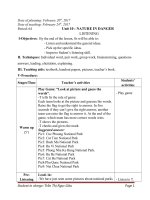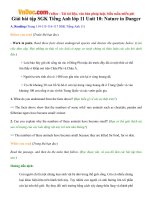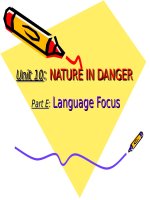Unit 10. Nature in danger
Bạn đang xem bản rút gọn của tài liệu. Xem và tải ngay bản đầy đủ của tài liệu tại đây (169.35 KB, 8 trang )
<span class='text_page_counter'>(1)</span><div class='page_container' data-page=1>
UNIT 10:NATURE IN DANGER
<b>Part D: Writing</b>
<b>A. Objectives: </b>
<b>1. Aims: </b>By the end of the lesson students will be able to write a paragraph to describe the
national parks base on provided information.
<b>2. Knowledge: </b>
- Language: The simple present of verbs and the connectors often used in a narrative.
- New words: Words related to national park.
<b>3</b>. <b>Skill:</b>Developing such reading facts and figures to make the outline of writing a
description of a national park.
<b>B. Methods:</b> Integrated, mainly communicative.
<b>C. Teaching aids: </b>Textbook, chalk, board,….
<b>D. Procedures:</b>
<b> </b>
<b>1. Settlement: </b>(1m) Greeting the class and checking Ss’ attendance<b> 2. New lesson: </b>
<b>Teacher’s activities</b> <b>Students’ activities</b>
<b>I.Warm – up ( 5 ms)</b>
- Ask students to keep their books closed.
- Ask students some following questions:
<i>1. Have you ever been to national park?</i>
<i>2. What is it famous for? </i>
<i>3. How did you feel when you visited it?</i>
<b>II. Pre – writing (10 ms)</b>
- Ask student to read the task
- Explain some new words:
<i>Tropical forest (n.p)= rain forest</i>
<i>Coastal water (n.p):water which is near coast</i>
<i>Abundant (adj) = plentiful (adj) </i>
<i>Stone tool(n.p)</i>
- Ask students to look through the passage again and
answer the questions:
<i>1. Where is Cat Ba National Park located?</i>
<i>2. What are the features of Cat Ba National Park?</i>
<i>3. How large is it?</i>
<i>4. What do you know about the animals and plants in</i>
<i>Cat Ba National Park?</i>
<i>5. What are some of historic features of the Park?</i>
- Let them work in groups.
-Help students make the detail outline of writing.
<b>Out line</b>:
* <b>Introduction</b> (Location + area)
+ Cat Ba National park / an important national park/
northern Vietnam.
+ Be located / Cat Ba island / an area of 15,200
<i>ha,120 / Ha noi / 20 km / Hai Phong</i>
<b>* Special features( </b>the number of animals and
plants)
+ Cat Ba national park / the only site / Viet Nam /
- Keep books closed.
- Listen to the teacher and answer the questions
<i>1. Yes, I have .Hanoi</i>
<i>2</i>
<i>3.- It is very interesting</i>
-Do as told.
-Group work.
<i><b>Useful language</b></i>
<i>It’s located in/on…………..</i>
<i>It’s famous for………</i>
<i>It covers/contains…….</i>
<i>Its total area is………</i>
<i>There are…….species of/kinds of/sorts of……</i>
<i>We can find………</i>
<i>Something is found in…………..</i>
-Listen and copy down.
</div>
<span class='text_page_counter'>(2)</span><div class='page_container' data-page=2>
<b>Teacher’s activities</b> <b>Students’ activities</b>
both tropical forest /coastal waters / white sand
beaches/ abundant natural sources / many kind of
rare animals and plants / this park/ preserve/ 300
species of fish/ 40 species of animals/ 150 species of
birds/ 620 species of plants
<b>* Historic features</b>
On this island park / people / find 6000-year old
stone tools and human bones in limestone caves/
( 6000-year old stone tools and human bones found
there / reveal /people/ inhabited/ there / 6000 years
ago)
<b>* Conclusion</b>
Nowadays, Cat Ba still attracts visitors by its pristine
beauty and legends of its history and culture.
<b>III. While – writing (15 ms)</b>
- Ask students to write a description of Cat Ba
National Park, using the facts and figures.
- Let students work individually
- Walk round and help students
<b>IV. Post – writing (10ms)</b>
- Give suggestions and corrections.
- Ask students to read another’s narrative.
- Ask some students to read loudly their narratives.
- Correct mistakes and give mark.
<b>V. Consolidation and homework: (4 ms)</b>
- Summary the main point of the lesson.
- Assign homework:
+ Do Writing at home
+ Prepare Part E: Language Focus
-Individual work.
- Listen to the teacher and finish the narrative.
- Read a narrative of one classmate.
- Some students read loudly their products in front
of the class.
- Listen and correct mistakes.
<b>*Sample writing:</b>
<i>Cat Ba National Park is located in Cat Ba Island,</i>
<i>Hai Phong. It is 120 km from Hanoi and 20 km</i>
<i>east of Hai Phong city centre. It is 15,200 square</i>
<i>hectares in total.</i>
<i>The park is characterized by beautiful tropical</i>
<i>forests and coastal waters. It is famous for</i>
<i>magnificent landscapes with white sand beaches</i>
<i>and abundant natural resources.</i>
<i>Many kinds of rare and precious animals and</i>
<i>plants live in Cat Ba National Park. It is home to</i>
<i>300 species of fish, 40 species of animals, 150</i>
<i>species of birds and 620 kinds of plants.</i>
<i>Cat Ba National Park is also a historic site.</i>
<i>Archeologists found 6000-year-old stone tools and</i>
<i>even human bones. So the park is not only a </i>
<i>tourist</i>
<i>attraction but also a good place for historians and</i>
<i>archeologists to study the past.</i>
<i>-Listen to the teacher.</i>
-Listen.
<i><b>*Self-evaluation:</b></i>
</div>
<span class='text_page_counter'>(3)</span><div class='page_container' data-page=3>
UNIT 10:NATURE IN DANGER
<b>Part E: Language Focus</b>
<b>A. Objectives: </b>
<b>1. Aims: </b>By the end of the lesson students will be able to:
- Practice reading correctly the clusters: /sl/, /sm/, /sn/ and /sw/
- Consolidate how to use relative pronouns with prepositions.
<b>2. Knowledge: </b>
- Lexical items: words and sentences pronounced in / sl/,/sm/,/sn/, /sw/
- Grammar items: relative pronoun with prepositions
<b>3</b>. <b>Skill:</b> Developing reading skill, doing different kinds of exercises on relative clauses.
<b>B. Methods:</b> Integrated, mainly communicative.
<b>C. Teaching aids: </b>Textbook, chalk, board,….
<b>D. Procedures:</b>
<b> </b>
<b>1. Settlement: </b>(1m) Greeting the class and checking Ss’ attendance<b> 2. New lesson: Part E: Language Focus</b>
<b>Teacher’s activities</b> <b>Students’ activities</b>
<b>A.Pronunciation (14ms)</b>
<b>I. Warm – up </b>
- Give some words that are jumbled to ask students
to rearrange: miws, wons, llams, peels
- Sum up and lead in.
<b>II. Presentation</b>
- Model the four clusters/sl/, /sm/, /sn/ and /sw/ for
a few times and explain how to produce them.
- Play the tape once for students to hear the words
containing these clusters. Then play the
tape(or read) again and this time ask
students to repeat after the tape (or
Teacher)
<b>/sl/</b> <b>/sm/</b> <b>/sn/</b> <b>/sw/</b>
slave small snack swallow
sleep smart sneeze swim
slim smell snooker swing
slowly smoke snowy switch
- Ask students to read the words in each column
out loud in chorus for a few times.
- Call on some students to read the words out loud.
- Listen and correct their pronunciation.
<b>III. Practice</b>
- Ask students to work in pairs and take turn to
read aloud the dialogue.
- Call on some pairs to read the dialogue again and
provide corrective feedbacks.
<b>IV. Free – practice</b>
- Give some words and ask students to put them in
-Do as told.
Key: swim, snow, small, sleep.
-Listen.
-Listen.
-Whole class
-Whole class, individual work and pair work.
-Practise the dialogue.
-Pair work.
-Do as told.
<b>/sl/</b> <b>/sm/</b> <b>/sn/</b> <b>/sw/</b>
</div>
<span class='text_page_counter'>(4)</span><div class='page_container' data-page=4>
<b>Teacher’s activities</b> <b>Students’ activities</b>
the right columns: slice, smooth, sniffles, sweet,
snail, slipper,smile, sweden.
- Ask students to give some more words containing
the target cluster consonants.
<b>B. Grammar (27ms)</b>
<b>I.Warm – up </b>
- Write two sentences on the board:
<i>Is that the man?</i>
<i>You arrived with him.</i>
- Ask students to combine the two sentences into
one, using a suitable relative pronoun:
- Ask students which one of the two sentences is
correct.
- Give feedback, introduce relative pronouns with
prepositions:
<b>II. Presentation</b>
- Giới từ trong MĐQH thường được đặt ở cuối
MĐQH nhưng trong văn viết hoặc để diễn đạt ý
một cách trang trọng, giới từ thường đặt trước đại
từ quan hệ.
- Giới từ không đứng trước ĐTQH <b>that and who.</b>
- Chúng ta cũng dùng Preposition + ĐTQH sau dấu
phẩy trong loại mệnh đề không-xác-định.
Ex:
Mr.Reese, to whom we sent the letter, hasn’t given
us his reply.
- of which, of whom, of whose đc dùng sau các
từ chỉ số lượng (all, both, many, most neither,
none, some….) và dạng so sanh nhất.
Ex: We’ve taken many tests, most of which were
difficult.
Ex: They have four children, all of whom are
married.
<b>III. Controlled – practice </b>
<b>Exercise 1: Choose the suitable words</b>
- Instruct the exercise to students:choose the
italicized words to complete the following
sentences
-Ask students to do the exercise individually
-Ask them to compare their answers with another
-Call on some students to read their answers in
front of the class and explain
-Listen and give the correct answers:
<b>Exercise 2: Combining </b><i>the following sentences </i>
<i>,using the preposition + whom or which</i>
<i><b> Is that the man whom you arrived with?</b></i>
<i><b> Is that the man with whom you arrived?</b></i>
<b>Ex</b>:
+The man is living near your house. I talked to him
on the phone last night.
=> The man <b>to whom</b> I talked on the phone last
night is living near your house.
+ The bed wasn’t comfortable. I slept in it last
night.
=>The bed <b>in which</b> I slept last night wasn’t
comfortable.
-Do the exercise individually
-Compare their answers with their friends
-State the answers
( some. others compare, add and correct)
<i><b>Suggested answers:</b></i>
<i>1.whom 2.which </i>
<i> 3.whom 4.who/that </i>
<i>5.which 6.whom 7.which</i>
- Listen to the teacher and do exercise 2
<i><b>Suggested answers:</b></i>
<i>1.The man to whom I talked yesterday was very</i>
<i>kind</i>
<i>2. The man about whom I told you works in</i>
<i>hospital</i>
</div>
<span class='text_page_counter'>(5)</span><div class='page_container' data-page=5>
- Introduce Exercise 2 to students and explain how
to do it
- Ask students to do it
- Let them work in pairs.
- Check, correct mistakes.
<b>IV. Free – practice</b>
<b>Exercise 3: complete the following sentences</b>
<i>using who, whom, which ,or that</i>
-Instruct the exercise to students:
- Ask students to do the exercise individually
-Ask them to compare their answers with another
- Call on some students to give feedback
- Listen and give thecorrect answers.
<b>C. . Consolidation and homework: (3ms)</b>
- Summary the main point of the lesson.
- Assign homework:
+ Do exercises in workbook.
+ Prepare Unit 11: Sources of energy
Part A: Reading
<i>4. The movie about which they are talking is</i>
<i>fantastic</i>
<i>5. The picture at which she was looking was</i>
<i>beautiful</i>
<i>6. I’ll give you the dress to which you should write</i>
-Listen.
-Do the exercise individually
-Compare their answers with their friends
- Answer.
<i><b>Suggested answers:</b></i>
<i>1.that 2.which </i>
<i> 3. who/that 4.whom </i>
<i>5.which 6.which </i>
<i>7.who/that 8.whom</i>
- Listen.
-Listen to the teacher.
<i><b>*Self – evaluation:</b></i>
………
………
………...
UNIT 11:SOURCES OF ENERGY
Week : 23
</div>
<span class='text_page_counter'>(6)</span><div class='page_container' data-page=6>
<b> Part A: Reading</b>
<b>A. Objectives: </b>
<b>1. Aims: </b>
<b>- </b>Helping students understand about the alternative sources of energy in our lives.
- Helping students understand about the advantages and disadvantages of each alternative
source of energy.
- Understand the importance of saving sources of energy in our life
- Helping students practice reading skills.
<b>2. Knowledge: </b>
- General knowledge: By the end of the lesson, students will be able to understand more
about the different sources of energy and use the information they have read to discuss the
topic.
- New words: Words related to sources of energy
<b>3</b>. <b>Skill:</b>Develop such reading micro-skills as scanning for specific ideas and guessing
meaning in context.
<b>B. Methods:</b> Integrated, mainly communicative.
<b>C. Teaching aids: </b>Textbook, chalk, board, some photos of sources of energy….
<b>D. Procedures:</b>
<b> 1. Settlement: </b>(1m) Greeting the class and checking Ss’ attendance
<b> 2. New lesson: </b>
<b>Teacher’s activities</b> <b>Students’ activities</b>
<b>I.Warm – up (5ms)</b>
- Ask students to work in pairs to complete the
sentences.
<i>1. We use ... to cook</i>
<i>2. We use ... to run the machines, cars, motorbikes<b>. </b></i>
<i>3. Which word is used to describe the group of </i>
<i>words: coal, gas, and oil?</i>
- Call on some students to stand up and give their
answers.
- Summarize and lead in.
<b>II. Pre – reading (9ms)</b>
<i>- Ask students to work in pairs to look at the pictures </i>
and then answer the questions.
<i>1. What can you see in the pictures? </i>
<i>2. What source of energy does each picture refer</i>
<i>to? </i>
<i>3. What do you need energy for? </i>
<i><b>- </b></i>Gather the ideas and help students to give suggested
answers.
- Provide students with new words/phrases:
<i>Consumption(n)= use something</i>
<i>Nuclear energy(n.p): năng lượng hạt nhân</i>
<i>Geothermal heat(n.p): hơi nóng địa nhiệt</i>
<i>Dam(n): đập nước</i>
<i>Plentiful(adj):sung túc , phong phú, dồi dào</i>
<i>Potential(adj): tiềm năng</i>
<i>Make full use of (v.p)</i>
-Work in pairs to do the task.
<b>Suggested answers.</b>
<i>1. oil, coal, natural gas</i>
<i>2. gas</i>
<i>3. fossil fuels</i>
-Answer.
- Listen.
- Work in pairs and state the answers( may vary)
<b>Suggested answers</b>
<i> 1. we can see windmill, solar panel, hydroelectric </i>
<i>dam</i>
<i><b> 2</b>.They are wind energy, solar energy and water </i>
<i>power</i>
<i><b> 3</b>.We need energy to live and work :drive out </i>
<i>machine, light and heat our houses and produce </i>
<i>something in industry and agriculture</i>
</div>
<span class='text_page_counter'>(7)</span><div class='page_container' data-page=7>
Fossil fuel (n.p)
power(n) =energy
create(v) = produce
entire(a) = whole
Infinite(a)
Exhaust (v)
Exhausted(a) kiệt sức, mệt lử
Potential(a)
- Read each word/phrase 3 times and ask students to
repeat them.
- Guide to read and correct mistakes.
<b>III. While – reading (20ms)</b>
<b>Task 1</b>
-Ask students to read the requirements of the task.
-Ask them to read the words in the box carefully,
then instruct them to read the passage quickly and
stop at the lines that contain these words to guess
their meanings based the context in these sentences
- Ask students to work individually to do the task
- Ask them to compare their answers with a friend
- Call on some students to read their answers in
front of the class.
- Listen and provide feedbacks.
<b>Task 2</b>
-Instruct the task to students.
-Ask students to read the text and defineadvantages
and disadvantages of each alternative source of
energy and write down
-Call on some students to explain their answers in
front of the class
-Make necessary and corrections
-give correct answers.
<b>Task 3</b>
-Ask students to read the passage again then answer
the questions
- Let them work in pairs
- Help students if necessary
- Practise reading these words by themselves.
- Read aloud in chorus and individually.
- Answer
-Listen to teacher’s instructions
-Do the task individually and compare with their
partner.
<b>Answers</b>
<i>1.released 2.alternative 3.energy </i>
<i>4.limited 5.exhausted </i>
-Listen.
- Pair work.
<b>Answers</b>
<i><b>Sources of </b></i>
<i><b>energy</b></i> <i><b>advantages</b></i> <i><b>disadvantages</b></i>
<i>Nuclear </i> <i>unlimited</i> <i>Very </i>
<i>dangerous(due </i>
<i>to radioactivity)</i>
<i>Solar </i> <i>Available/ </i>
<i>plentiful/ </i>
<i>infinite</i>
<i>Only possible </i>
<i>during sunny </i>
<i>days</i>
<i>Water </i> <i>Clean/</i>
<i>unlimited</i> <i>expensive</i>
<i>Wind </i> <i>Clean/</i>
<i>unlimited</i> <i>No wind/no energy</i>
<i>Geotherma</i>
<i>l heat</i>
<i>available</i> <i>Only in few </i>
<i>places</i>
-Do as told.
-Pair work.
<i><b>Suggested answers:</b></i>
<i>1. Fossil fuels ( oil, coal , and natural gas)</i>
<i>(line1,paraghaph1)</i>
</div>
<span class='text_page_counter'>(8)</span><div class='page_container' data-page=8>
<b>Teacher’s activities</b> <b>Students’ activities</b>
<b>IV. Post – reading (7ms)</b>
<b>(For good students)</b>
- Ask students to work in groups to complete the
summary of the reading passage by filling each
blank with a suitable word from the box
- Go around to help the groups when necessary
- Call on some groups to answer the question
- Listen to students and correct mistakes.
<b>V. Consolidation and homework: (3ms)</b>
- Summary the main point of the lesson.
- Assign homework:
+ Learn by heart new words.
+ Prepare Part B: Speaking
- Listen to the teacher
-Discuss and complete the summary of the reading
passage by filling each blank with a suitable word
from the box
- The students who are called to stand up to talk
loudly are intelligent ones
<b>Answers: </b>
<i>1. energy 4.limited </i>
<i>2. one 5.alternative</i>
<i>3. fuels 6.source</i>
<i> 7.unlimited 8.environtment</i>
-Listen.
-Listen.
<i><b>*Self – evaluation:</b></i>
</div>
<!--links-->
Slide english 11 unit 10 nature in danger _listening _N.H Tuyet
- 34
- 993
- 3








